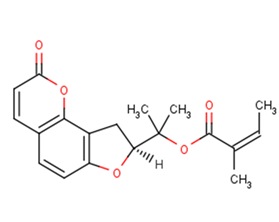
Columbianadin
CAS No. 5058-13-9
Columbianadin( Columbianadin | CBN )
Catalog No. M17528 CAS No. 5058-13-9
Columbianadin, one of the main bioactive constituents of the roots of Angelica pubescens Maxim. f. biserrata Shan et Yuan, has been found to possess obvious pharmacological effects in previous studies.
Purity : >98% (HPLC)
 COA
COA
 Datasheet
Datasheet
 HNMR
HNMR
 HPLC
HPLC
 MSDS
MSDS
 Handing Instructions
Handing Instructions
| Size | Price / USD | Stock | Quantity |
| 10MG | 54 | In Stock |


|
| 100MG | Get Quote | In Stock |


|
| 200MG | Get Quote | In Stock |


|
| 500MG | Get Quote | In Stock |


|
| 1G | Get Quote | In Stock |


|
Biological Information
-
Product NameColumbianadin
-
NoteResearch use only, not for human use.
-
Brief DescriptionColumbianadin, one of the main bioactive constituents of the roots of Angelica pubescens Maxim. f. biserrata Shan et Yuan, has been found to possess obvious pharmacological effects in previous studies.
-
DescriptionColumbianadin, also known as CBN, is a natural coumarin from Angelica decursiva (Umbelliferae). CBN is known to have various biological activities including anti-inflammatory and anti-cancer effects.
-
In VitroColumbianadin (CBN) effectively suppresses the growth of colon cancer cells. Low concentration (up to 25 μM) of Columbianadin induces apoptosis, and high concentration (50 μM) of Columbianadin induces necroptosis. The induction of apoptosis by Columbianadin is correlated with the modulation of caspase-9, caspase-3, Bax, Bcl-2, Bim and Bid, and the induction of necroptosis is related with RIP-3, and caspase-8. In addition, Columbianadin induces the accumulation of ROS and imbalance in the intracellular antioxidant enzymes such as SOD-1, SOD-2, catalase and GPx-1. Columbianadin shows the most effective growth inhibitory activity against human colorectal cancer cells. Accordingly, further study is performed using HCT116 cells to give the detailed growth-inhibitory mechanism of action mediated by Columbianadin. The cells treated with various concentrations of Columbianadin (0-100 μM) exhibit a dose- and time-dependent growth inhibition with an IC50 value of 47.2 and 32.4 μM after 48 and 72 h incubation, respectively. Treatment of various concentrations (12.5, 25, and 50 μM) of Columbianadin for 48 h in HCT116 cells decreases the number of cells and increases the floating cells. Apparent morphological changes with round-shape and dying cells are also observed at 25 and 50 μM Columbianadin -treated cells.
-
In VivoThe analysis method is successfully applied to a tissue distribution study of Columbianadin (CBN) and Columbianetin (CBT) after intravenous administration of Columbianadin to rats. The results of this study indicated that Columbianadin can be detected in all of the selected tissues after i.v. administration. Columbianadin is distributed to rat tissues rapidly and can be metabolized to CBT in most detected tissues. Of the detected tissues, heart had the highest uptake of Columbianadin, which suggests that heart might be one of the main target tissues of Columbianadin .
-
SynonymsColumbianadin | CBN
-
PathwayOthers
-
TargetOther Targets
-
RecptorOthers
-
Research AreaOthers-Field
-
Indication——
Chemical Information
-
CAS Number5058-13-9
-
Formula Weight328.36
-
Molecular FormulaC19H20O5
-
Purity>98% (HPLC)
-
SolubilityDMSO : 33.33 mg/mL. 101.50 mM;H2O : < 0.1 mg/mL
-
SMILESC/C=C(\C)/C(=O)OC([C@@H]1Cc2c3oc(=O)ccc3ccc2O1)(C)C
-
Chemical Name(S)-2-(2-Oxo-8,9-dihydro-2H-furo[2,3-h]chromen-8-yl)propan-2-yl (Z)-2-Methylbut-2-enoate
Shipping & Storage Information
-
Storage(-20℃)
-
ShippingWith Ice Pack
-
Stability≥ 2 years
Reference
1. Zhang YB, et al. Biomedical Chromatography, 2016, 30(2):256-262.
molnova catalog



related products
-
Boc-NH-PEG11-NH2
Boc-NH-PEG11-NH2 is a PEG-based PROTAC linker that can be used in the synthesis of PROTACs.
-
Xenopsin-Related Pep...
Xenopsin-Related Peptide 2 (XP-2)
-
Obtucarbamate B
Obtucarbamate B has antitussive activity.



 Cart
Cart
 sales@molnova.com
sales@molnova.com


